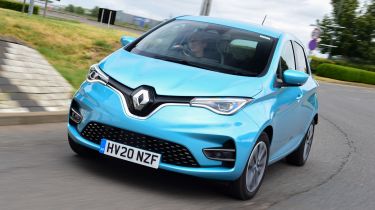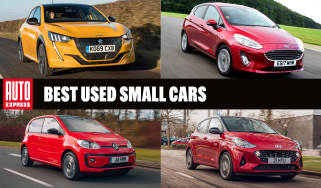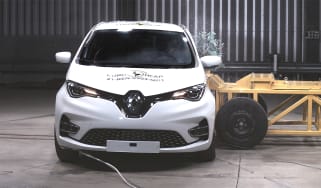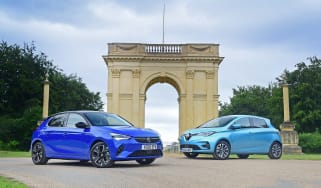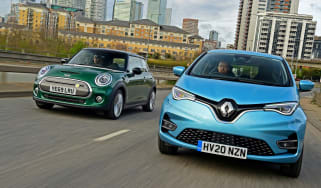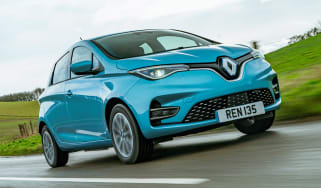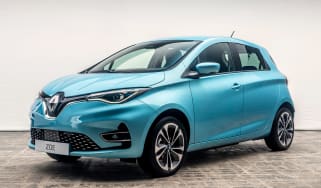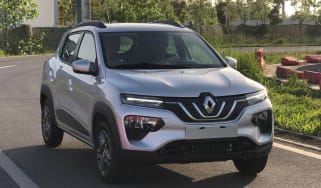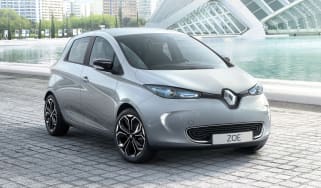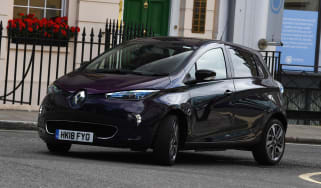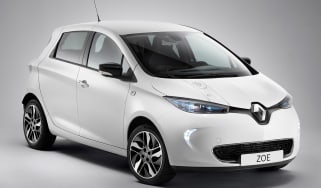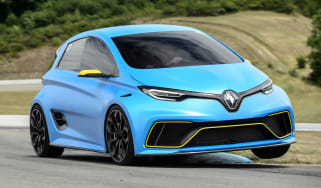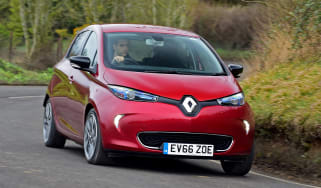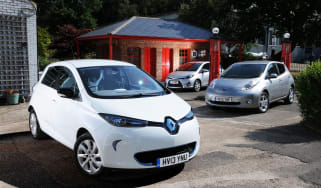Renault Zoe (2013-2024) review
The Renault Zoe is a capable small electric car, let down by its poor build quality and safety rating

From behind the wheel, the Renault Zoe feels much like a traditional combustion-engined supermini – albeit a much quieter one. It’s ideal for a family looking for a second car, as the Zoe suits shorter commutes and daily errands perfectly. It's still reasonably practical, offers nearly 240 miles of range and will cost you mere pennies to run.
However, after more than a decade on showroom floors and with new fresh faced competition arriving thick and fast, the Renault Zoe is hanging on rather than leading the pack. It’s not as cheap as it once was either, and the zero-star rating from industry safety test body Euro NCAP makes it even harder to recommend.
About the Renault Zoe
The Renault Zoe was one of the world’s first affordable electric cars, having been introduced all the way back in 2012, just two years after the original Nissan Leaf hit the streets. Since then we’ve had two generations of the bubble-shaped supermini, which for quite some time was Renault’s only electric passenger car. That, of course, changed in 2022 when the Renault Megane E-Tech hatchback arrived, with more Renault EVs on the way, including the reborn Renault 5.
The small electric car market has exploded since the Zoe first arrived, so there’s now plenty of competition. The Zoe’s closest rivals are other zero-emissions superminis like the Peugeot e-208, Vauxhall Corsa Electric and Ora Funky Cat, all of which offer similar levels of practicality and range. Though the Zoe trumps the lot with its impressive 338-litre boot and 249-mile range.
Used - available now

2026 BMW
4 Series
26,030 milesAutomaticPetrol2.0L
Cash £25,997
2025 Audi
A5 Sportback
37,025 milesAutomaticDiesel2.0L
Cash £25,197
2026 BMW
i4
25,438 milesAutomaticElectric
Cash £29,197
2023 Land Rover
Range Rover Evoque
28,804 milesAutomaticPetrol1.5L
Cash £25,697Stylish rivals such as the Fiat 500, Honda e and MINI Electric are sure to catch the attention of buyers looking for a smart, sophisticated urban runabout, however these are still city cars first and foremost so boot space is limited, as is driving range. Some of the cheaper electric family hatchbacks will give the Zoe a run for its money too, with the MG4 EV in particular offering more range, sharper looks and more modern tech for less money.
Speaking of money, the Zoe’s starting price has now ballooned to nearly £30,000 after the Government’s plug-in car grant was axed, among other things. The trim structure and powertrains available have also been cut back recently. For instance, the Zoe was previously available with two outputs from its single, front-mounted electric motor: an R110 model with 107bhp or an R135 version with 134bhp, the more powerful version being the only option now.
Buyers get a choice of Techno and Iconic trim, the only major differences being that pricier Iconic models get 50kW rapid charging and 17-inch alloy wheels as standard. The standard kit list on even the entry-level Zoe is pretty strong, with every model featuring LED head and tail-lights, a 10-inch instrument panel and a 9.3-inch central portrait touchscreen running Renault’s EasyLink infotainment system with built-in sat-nav, plus Apple CarPlay and Android Auto connectivity.
The Zoe also benefits from blind-spot monitoring, front and rear parking sensors and a reversing camera. It lacks several crucial airbags, however, which is just part of the reason why it received a zero-star Euro NCAP safety score in 2021.
How much does the Renault Zoe cost?
The Renault Zoe is no longer available to order new, as production ended in 2024. Limited new stock may still be found at select dealerships, with remaining models like the Techno R135 and Iconic R135 Boost Charge previously priced around £25,000. In the used market, prices are far more accessible, with 2018 models available from around £5,500 and 2020 examples priced from approximately £8,300, depending on condition and mileage. Leasing options for remaining new stock, where available, may start from around £470 per month, but availability is extremely limited.
Electric motor, drive and performance
The Zoe uses a single electric motor to drive the front wheels, powered by a 52kWh battery which is fairly large for this size of EV but does allow it to cover up to 239 miles on a single charge.
The car is at its best around town, where the light steering and zippy, instantaneous power delivery make the Zoe a relaxing and easy drive, even in the hustle and bustle of a city or when navigating tight multi-storey car parks. The noise that the car emits at low speeds to warn pedestrians of your presence can be quite irritating after a while, but it’s a small price to pay to help prevent anyone walking out in front of you.
Once you hit the open road, the Zoe isn’t as well-rounded as its competitors. The ride is generally well composed, although the firm suspension can send a thump through the cabin over larger potholes and on particularly uneven surfaces the ride can become a bit choppy.
Body control isn’t dreadful, but the Zoe does roll a bit even with the 326kg of batteries mounted beneath the floor. There are only two levels for the regenerative braking system, D which allows the car to coast like a petrol or diesel model, or B that slows you down when you lift off the throttle. It’s not quite capable of one-pedal driving like a Nissan Leaf, but it’ll get you pretty close.
Road noise is reasonably well contained, but wind noise becomes fairly intrusive at higher speeds. When we tested early Zoes the light trim often reflected in the windscreen, but thankfully this was fixed from 2015 models onwards. It’s just a shame the issue of nasty blindspots created by those thick, sweeping A-pillars still hasn’t been addressed.
0-62mph acceleration and top speed
The Zoe was previously available with two power outputs: the R110 powertrain produces 107bhp with 225Nm of torque, while R135 models deliver more straight-line shove with 134bhp and 245Nm of torque on tap. Renault only offers the R135 setup now, which is pretty sprightly off the mark with 0-30mph taking 3.6 seconds.
However, push on and you’ll notice the Zoe runs out of puff, as it struggles at higher speeds and on steep inclines. The R110 version takes 11.4 seconds from 0-62mph, with a top speed of 84mph. The R135 is able to make the same sprint to 62mph in 9.5 seconds, before topping-out at 90mph.
You’ll also need to be out of Eco mode if you want to utilise all of the Zoe’s power. Eco, the default setting for the car, dulls the throttle response and limits the top speed to less than 60mph. You turn it off using a switch on the dashboard, or by pushing on the throttle hard enough, though in that case the Zoe will return to Eco mode once you ease off.
Range, charging and running costs
You used to have to lease the battery in the Zoe, the main reason being that battery leasing helped lower the initial purchase price of the car and ensure it was as close as possible to that of an equivalent diesel car. However, times have changed and enhanced residual values of electric vehicles caused Renault to simplify things for customers. Now the battery is included in the price of the electric supermini, like it is with any other EV.
Every Zoe features a 52kWh battery and offers a maximum range of 239 miles based on the WLTP test cycle, or 223 miles if you go for the 17-inch wheels. For context, that blows the pants off zero-emissions city cars like the MINI Electric and Honda e which can only cover around 100 miles on a full charge, while the Peugeot e-208 and Vauxhall Corsa Electric will run out of juice after about 220 miles on the road. The MG4 EV in Long Range form pips the Zoe, however, with its range of up to 281 miles.
It's worth noting that, like with all electric cars, the Zoe will struggle to achieve close to its maximum range in colder temperatures and with the use of power-sapping features in the car such as the climate control. Renault itself acknowledges that, in colder winter months, the battery range could be just 150 miles on average.
Charging at home is simple, with a 7.4kW wallbox capable of fully replenishing the Zoe’s 52kWh battery in nine and a half hours. You can get a three-pin cable for plugging into a standard socket at home, but it’ll take 32 hours to fill up from zero to 100 per cent capacity this way, so it’s really only a last resort for when you’re away from home and running desperately low on charge.
We’re more disappointed by the Zoe’s rapid charging capabilities, or lack thereof. The entry-level Zoe can only charge at up to 22kW, while those equipped with the upgraded R135 Boost Charge set-up get a CCS charging port in their nose and can reach 50kW. That’s still well behind the 100kW or more the e-208, Corsa Electric and MG4 will charge at.
As a result, it’ll take you close to an hour to charge the Zoe from 10 to 80 per cent capacity using a 50kW rapid charger, while the MG4 can take advantage of the UK’s growing number of ultra-rapid chargers and do the same 10 to 80 per cent top-up in half an hour. Something definitely worth bearing in mind if you do even the occasional long journey.
Insurance groups
Insurance groups for the Zoe start at group 18 for the base R135 Techno and R135 Boost Charge Techno, and move up to group 19 for the R135 Boost Charge Iconic. The costs are kept down partly because of the Zoe’s modest performance, and partly because the mileage expectations are so low.
Check if your car needs an MoT and view its complete history with our MoT History Checker...
Depreciation
Expert data suggests the Zoe will retain between 45 and 52 per cent of its original value over three years and 36,000 miles. This is a marked improvement over the previous model and should provide increased confidence for private buyers.
Check out our Free Car Valuation tool for a current price on a specific model.
Interior, design and technology
Renault says the Zoe was designed “from the ground up” as an electric car, although it has been developed on the platform used by the Renault Clio, as well as the Nissan Note.
The Zoe is distinctive thanks to its neat light clusters, and a sleek exterior with few features to disrupt the airflow and cause unwelcome drag. Notably, it also has a high shoulderline and small window area designed to cut heat build-up and loss – important for reducing the demands on the battery-sapping climate control.
There are now just two trim levels for the Zoe – Techno and Iconic – the only difference being pricier models get 17-inch alloy wheels and 50kW rapid charging as standard. Glacier White is the standard paint colour, with another six hues on the options list. Specifying one of the metallic colours will cost either £600 or £700.
Inside, the interior borrows heavily from the latest Clio and Captur, making use of soft-touch plastics along the dashboard, but instead of conventional dials, the Zoe features a 10-inch digital driver’s display that shows your range and speed, as well as graphics telling you whether the regenerative systems are pumping energy back into the battery, or discharging it.
Renault has tried to create a modern, minimalist feel with lots of light-coloured trim, but has stuck with rotary dials for the climate controls and physical buttons on the dash and steering wheel so everything is easy to find and control on the move. The result is a very functional cabin that lacks the flair or premium quality of rivals like the Peugeot e-208. The material and build quality doesn’t match the Zoe’s roughly £30,000 starting price either, which will turn some buyers off if their shortlist also includes the MG4 EV, Nissan Leaf or e-208.
Sat-nav, stereo and infotainment
The Zoe used to be fitted with either a seven- or 9.3-inch portrait central touchscreen depending on which specification you went for, but now all models feature the larger display running Renault’s EasyLink infotainment system. The graphics are sharp enough and the menus are relatively easy to navigate, but the screen isn’t the most responsive we’ve seen in this class of EVs. Luckily, Apple CarPlay and Android Auto smartphone connectivity are standard across the line-up, as is sat-nav.
Practicality, comfort and boot space
As a full five-seater with a 338-litre boot, the Zoe is a reasonably practical option if you regularly carry passengers and luggage. In fact, the packaging is so impressive that the car’s accommodation is pretty much a match for any supermini out there. The Zoe doesn't come as standard with a traditional three-pin home charging socket, so buyers planning occasional longer trips away from home will need to fork out for it on the options list.
Dimensions and size
The Zoe is based on the same platform as the Renault Clio. But while it’s the same width and wheelbase, it’s longer and over 10cm taller – a result of packaging the battery under the back seats. The slightly bulbous exterior styling means the Zoe seems huge when parked next to the Volkswagen up!, although you don’t get that same impression once you’re in the driver’s seat, and the Renault feels compact on the road.
The only slight quirk is that the seating position feels a little too high – again as a result of the need to place the seats on the top of the battery pack.
Leg room, head room & passenger space
There’s just enough space in the Zoe for five occupants, and the rear seats will even accommodate six-footers on a short journey. However, the upright seating position and high floor means they may not be terribly comfortable for long. The driver’s seat is not adjustable for height (because of the position of the batteries), and although the steering wheel moves for reach and rake, we’ve found it’s difficult to find the ideal seating position if you’re on the tall side.
Boot space
The 338-litre boot is a good size for a small, Fiesta-sized car like the Zoe, especially considering the larger but similarly priced MG4 EV only offers 25 litres of extra cargo space. With the split-folding rear bench down the luggage capacity jumps to 1,225 litres, which is more than either the Peugeot e-208 or Vauxhall Corsa Electric boasts. You will have to contend with the high load lip whenever you want to chuck anything heavy into the Zoe’s fairly deep boot, and because of the batteries located beneath the rear seats you don’t get a flat load area.
Reliability and safety
The Renault Zoe has been on sale for over a decade at this point, and in that time it’s proven itself to be a very reliable car with no major issues reported with either the first or second generations of the small, simple electric car. The previous-generation model also consistently ranked high in our Driver Power owner satisfaction surveys, receiving praise for their running costs and powertrain in particular.
However, some buyers may be concerned by the Zoe’s safety rating. Euro NCAP awarded the Zoe a full five-stars for safety in 2013, with an 89% score for adult occupant protection and an 80% rating for child passenger security. The industry body then tested the latest model in December 2021 and, due to more stringent assessments and certain features not being offered as standard, it failed to achieve a star rating.
The Zoe scored 43 per cent for adult safety, with a 52 per cent rating for child passenger protection and just 14 per cent for safety assist technology. It didn’t perform well in the frontal offset crash test, and fared even worse in the side pole test which simulates hitting a tree or lamp post side-on.
Renault's decision to remove a head airbag from the list of safety kit counted against it, as did the lack of lane-departure warning or autonomous emergency braking (AEB) on the Zoe. Renault rectified this in January 2022 by making both safety technologies standard on the car, with other safety features including parking sensors, a reversing camera and a suite of safety aids including blind-spot monitoring and lane-keep assist.
Warranty
The Zoe is covered by a three-year warranty with unlimited mileage during the first 24 months, then limited to a total of 100,000 miles or three years, whichever comes first. The battery on the Zoe also comes with a separate 8 year/100,000 mile warranty.
Servicing
Service inspections are required annually, or every 18,000 miles. Renault also offers its Easylife service plans for the Zoe – covering three years/30,000 miles, or four years/40,000 miles.

